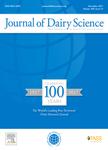版权所有:内蒙古大学图书馆 技术提供:维普资讯• 智图
内蒙古自治区呼和浩特市赛罕区大学西街235号 邮编: 010021

作者机构:Penn State Univ Dept Anim Sci University Pk PA 16802 USA Natl Anim Germplasm Program Ft Collins CO 80521 USA
出 版 物:《JOURNAL OF DAIRY SCIENCE》 (乳品科学杂志)
年 卷 期:2020年第103卷第5期
页 面:4510-4516页
核心收录:
学科分类:0832[工学-食品科学与工程(可授工学、农学学位)] 0905[农学-畜牧学] 08[工学]
基 金:USDA (Washington, DC) [58-5402-4-015] USDA National Institute of Food and Agriculture (Washington, DC) Hatch Appropriations [PEN04691, 1018545]
主 题:Y chromosome genetic diversity artificial insemination
摘 要:More than 99% of all known Holstein artificial insemination (AI) bulls in the United States can be traced through their male lineage to just 2 bulls born in the 1950s, and all Holstein bulls can be traced back to 2 bulls born in the late 1800s. As the Y chromosome is passed exclusively from sire to son, this suggests that variation is limited for much of the Y chromosome. Two additional male lineages that are separate from modern lineages before 1890 were present at the start of the AI era and had semen available from the USDA National Animal Germplasm Program (Fort Collins, CO). Semen from representatives of those lineages were used for in vitro embryo production by mating to elite modern genetic females, resulting in the birth of 7 bulls and 8 heifers. Genomic evaluation of the bulls suggested that lineages from the beginning of the AI era could be reconstituted to breed average for total economic merit in 1 generation when mated to elite females due to high genetic merit for fertility, near-average genetic merit for fat and protein yield, and below-average genetic merit for udder and physical conformation. Semen from the bulls is commercially available to facilitate Y chromosome research and efforts to restore lost genetic diversity.